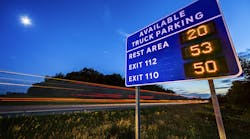I recently read about a group of eight Midwestern states that have launched Trucks Park Here, a program that informs drivers about the availability of parking along interstates. Indiana, Iowa, Kansas, Kentucky, Michigan, Minnesota, Ohio and Wisconsin now have a management information system on the number of parking spaces available at rest areas.
Road signs will display the number of parking spaces open up-to-the-minute at a rest area and how many miles it is to that stop.
Parking has become a big issue for drivers with many of them spending between 30 to 60 minutes trying to find a safe space to park. When they can’t find one, they often opt for any spot. The fact that there are so many trucks on the roads these days has made a bad situation worse. You can’t drive down a highway without seeing trucks parked on the side of the road or on off ramps. This is not safe for drivers, the freight or other motorists.
While there is no way to manufacture parking spaces overnight, there are some steps fleets can take to ease the parking problem.
- When was the last time you reviewed your vehicle routing in terms of planning it to potentially eliminate layovers and/or so drivers have layovers where parking is available?
- When you add a stop to a route, do you look at the impact that has on where the driver will end up when he needs to take his 10-hour rest or 34-hour restart?
- Can relays be established to eliminate some layovers?
- Examine each driver’s complete route. Will changing the order in which deliveries are made result in more parking options? If so, work with your customers to see if there is some flexibility with their delivery windows. Don’t assume that because you have always delivered to customer A at 11 a.m. that you always have to deliver to Customer A at that time. Perhaps customer A has a 3 p.m. delivery window. You won’t know if you don’t ask.
- Another option is to talk to your customers about whether they have room for you to park a truck or two from time-to-time. Remind them that you won't need the space all the time, but rather just a few times a week.
- You also can consider having drivers do their layovers before they make their first stop. In other words, if parking is available near their first stop, have them get to the first stop early and layover until it is time for them to make that delivery.
I understand that not all of these options will work for you, but it’s worth it to complete a routing analysis because you may be able to reroute some trucks to places where parking is more plentiful.
I think we all can agree with what Andy Barber, Kentucky Transportation Cabinet State Highway Engineer said: “Safe, convenient parking is crucial for commercial drivers.” The eight-state program hopes to help drivers locate safe parking so they don’t end up parking on highway shoulders, off ramps or at abandoned facilities.
Since some states have banded together to do their part, it’s time for every fleet to get on board and make reasonable routing changes that will help ease the situation even if only a little bit. These are some of the problems created by the strong economy. There are more trucks on the road. In some sense, this actually is a good thing. It will force us all to be a little more creative and to do things a little differently, but in the end, we should be more efficient.



